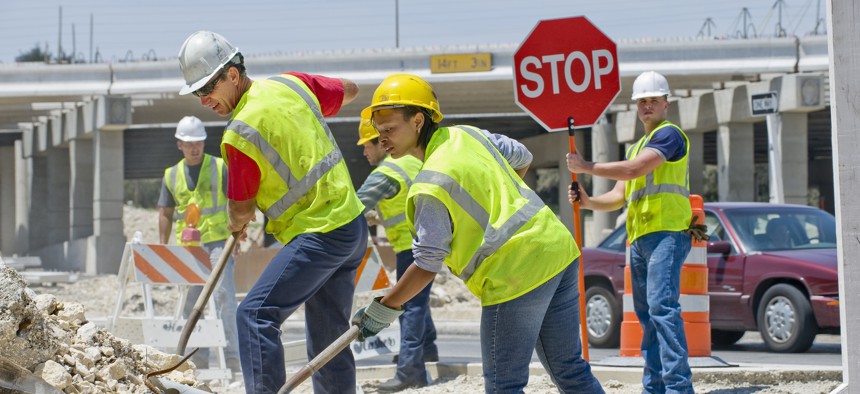4 Strategies to Create Good Jobs, Boost Equity With Federal Infrastructure Funds

Getty Images/Yellow Dog Productions
COMMENTARY | The Biden administration is judging applicants for new infrastructure grants based on their ability to do these two things. Here are four proven models to increase your community’s shot at winning funding.
With Infrastructure Investment and Jobs Act funds beginning to roll out, the Biden administration is working to ensure these investments create good jobs for workers from all walks of life. For example, IIJA requires that most new jobs pay market wages and benefits—and the administration is also preferencing grant applicants that will take additional steps to support working people.
While many cities and states already uphold high standards on publicly funded work, there is still room for improvement. As detailed in a new report from the Center for American Progress, policymakers should adopt four proven strategies to improve the lives of local workers–expand opportunities for women, workers of color, disabled workers and LGBTQI+ Americans–and increase their community’s shot at winning competitive IIJA funds:
1. Connect a new generation of workers to good jobs. IIJA encourages the expansion of high-quality training programs. For example, the law provides funding for new labor-management training centers for the installation and maintenance of energy-efficient building technologies. It also permits communities to use transportation funds to establish registered apprenticeships and preapprenticeships. Doing so will expand access to paid on-the-job training, support a steady pipeline of qualified workers, and open pathways for workers who have historically been excluded from these jobs.
California’s High Road Training Partnerships initiative and Wisconsin’s WRTP | Big Step program are leading examples of how to connect diverse cohorts of workers to good jobs and partner with labor and community organizations to support program quality and drive accountability. Similarly, local hire and apprenticeship mandates—adopted by jurisdictions ranging from San Francisco to Salt Lake County, Utah—can expand access to new industry entrants and support the retention of diverse workers.
2. Adopt project-specific agreements to support workers and local communities. Several IIJA grants prefer applicants that adopt project labor agreements, or PLAs, and similar project-specific agreements to establish wages, benefits and other employment standards. PLAs are often used in the public and private sectors to uphold fair standards for workers, prevent local firms from being underbid by bad actors that cut corners in project quality and standards, and avoid costly delays and disruptions caused by labor shortages or unrest.
Several states require PLAs on renewable energy projects. Similarly, in Anchorage, Alaska, officials evaluate whether a community workforce agreement is in the government’s interest before initiating large construction projects. Community workforce agreements incorporate PLA standards and additional community benefits, such as local hire and preferences for minority- and women-owned businesses. Increasingly, transit agencies are adopting policies that allow the incorporation of these agreements on publicly supported rail car and bus manufacturing jobs.
3. Weed out companies that violate workplace laws and lack a stable workforce. Dozens of state and local governments have improved the quality of their contractor pools by strengthening screening processes to identify prospective vendors with long records of committing fraud, wasting taxpayer funds, violating the law and lacking the proper experience and licensure. To support workforce stability and ensure that low-road contractors do not cut costs by misclassifying workers, many communities also require bidders to submit payroll records and participate in active registered apprenticeship programs.
Research finds that adopting these programs results in higher-quality and more reliable services, increased competition and reduced project delays and cost overruns. As Mike Repay, commissioner of Lake County, Indiana, put it, “It’s inherent that good public policy contemplate value for taxpayers, but you can’t get to the heart of value if bidders aren’t required to conform to good business practices … including the training and welfare of workers.”
4. Beef up enforcement of worker protections. Even the strongest workplace laws are meaningless if they aren’t enforced. Research shows that illegal activity is all too common in the construction industry, with company wage theft reducing a misclassified construction worker’s total compensation by up to 36%.
Policymakers should provide enforcement agencies with robust funding to monitor worksite compliance in real time. In addition, communities should adopt models established in Los Angeles County and Multnomah County, Oregon that supplement government enforcement activities by partnering with labor and community organizations to help educate workers on their rights and report violations.
Innovative state and local policymakers know what it takes to support workers and ensure a good value for public investments. Taken together, these pragmatic policies will strengthen local economies, maintain high standards across key industries and ensure law-abiding employers benefit from IIJA funding, and expand opportunity and increase the economic mobility of the next generation of American workers.
Karla Walter is the senior director of employment policy at the Center for American Progress.
NEXT STORY: The Best-Performing Cities in the US





